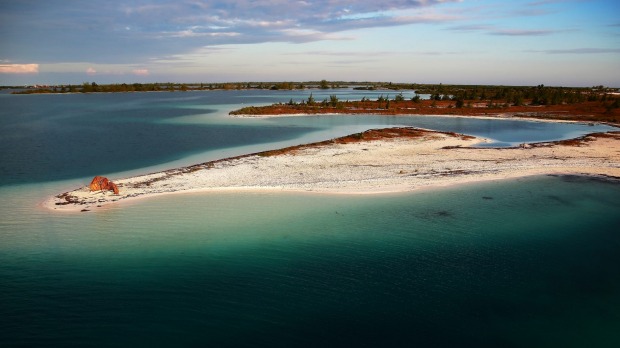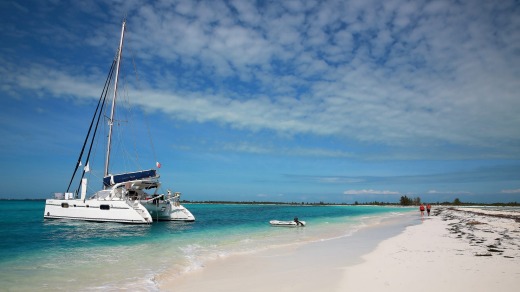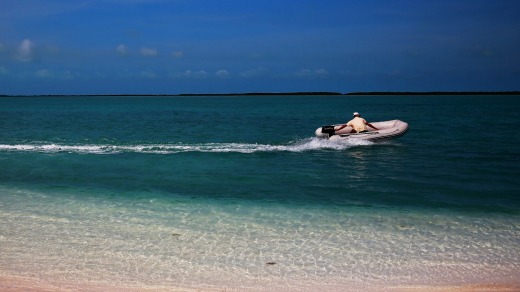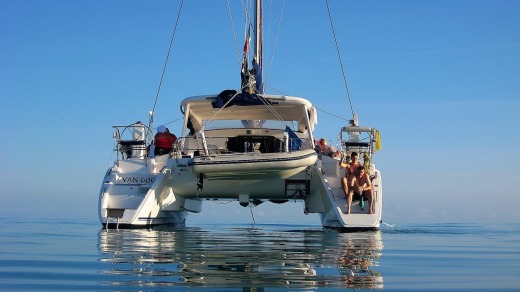
Tomorrow is tomorrow, says the Cuban sailor Gines Chavez Perez.
Thank God, I think, for tonight has outstayed its welcome. Our boat is a cork tossed about on the swell somewhere out in the great Gulf of Cazones that separates Cuba's coast from the Canarreos Archipelago scattered to its south.
Beneath us lies a chasm 2000 metres deep. The night is so black it has struck us blind: there is no moon, no stars by which to sail; not even the ocean's waves are betrayed by their foamy tips.

"Don't worry," says Perez, his face turned into the wind. "We sail using everything – sails, power! Tomorrow is tomorrow. We won't get lost."
We'd arrived in Cienfuegos just this afternoon, on the bus from Havana. On the way to the marina we'd passed rows of low-slung bungalows made over in benign shades of pastel and now advertised as holiday homestays.
This is where Cuban dictator Fulgencio Batista's cronies were said to have lived during his regime: officers, politicians, the American mafia. The marina itself – an opulent, historic construction – had operated as a casino in those days. Then came Fidel Castro and his revolution.

After dinner we'd struck out, leaving behind Cienfuegos and the jubilant late-night fiesta bubbling on its foreshore. Cruise ships and flashy yachts and catamarans were moored there, bobbing dinghies and doll-sized yachts whose bows barely poked above the water's surface and whose weathered bulwarks told a seafarer's tale.
This great bowl of a harbour once protected the inhabitants of Cienfuegos from hurricanes and pirates; in later years, it dispatched shiploads of Cuban shrimp and sugar destined for the few countries willing to trade with the communist, pariah state.
Today, it brims with interlopers: more vessels have passed through this port in the past two years alone that in the preceding two decades.

Cuba is slowly reforming; it has opened its doors to the world and welcomed it in.
The journey to paradise lasts six hours. In the morning I awake to find outside my cabin window a rocky isle lodged in a bath of clear water that stretches all the way to the horizon.
Last night's rabid seas have given way to calm: the reef shifts beneath the water's surface and though the sky is streaked grey there's no breeze on the air.
A fishing vessel is moored just off this craggy outcrop: while I was sleeping, Perez and our boat's captain, Miguel Fiallo Granda, boarded it to trade Havana rum in exchange for fresh fish.
But there's fish for the taking out here in this great big swimming pool of an ocean. Though the hangman bird casts his sinister shadow upon the sea – foretelling, so Cuban fishermen say, a poor haul – we can see for ourselves a plentitude of flying fish leaping from the depths and Perez' line pulling taught behind us as we glide westward.
The white shoreline of Cayo Largo del Sur soon comes into view, and it stays by our side all morning; but now we strike southwards and anchor just out of sight of land. Perez pulls on a wetsuit. The water is cold, he says: 26 degrees, around five less than the summer average. In winter, the ocean is a thermal layer cake, becoming progressively colder the deeper one goes.
"I've measured 21 degrees at the bottom in winter," he says, recoiling at the memory.
"In summer, it's 30, all the way down."
Spear gun in hand, Perez plunges in. I hesitate on the boat's edge and brace myself for a cold baptism in the Caribbean Sea.
The shock of fresh water on warm skin soon dissipates; now I'm sinking into a tepid underworld where coral forests sway lazily and fish flutter on the current.
I try to track Perez through my goggles but he's too quick for me, darting into the shadows, diving to the chilly depths, jabbing at dark places with his spear gun.
And then he pops to the surface, gun raised victoriously. Skewered on it are two fat, limp fish: dog snapper and hogfish, a feast for tonight's table.
The stars come out early here above Canarreos Archipelago. Orion's belt gobbles up the sky and the moon casts soft light upon the 350 islets languishing upon these waters.
Resorts are dotted sparingly about here, and they're indiscernible to us from our mooring. There are just eight of us on this catamaran – six travellers and two crew – and we might as well be all alone out here except for the mast lights betraying the handful of boats anchored in the bay.
This paucity of visitors evokes a Robinson Crusoe mood next day when we anchor off a deserted isle and are taken ashore in Granda's dinghy.
This blot of white sand and emerald scrub bears no name: it floats like a fragment of glory atop shallow, turquoise waters and can be circumnavigated by us, its only inhabitants, in a matter of minutes.
Granda takes off again in the dinghy, waving us goodbye and instructing us to be ready for pick-up in a couple of hours' time. My companions and I build a sand mermaid and scour the beach for flotsam with which to decorate her: shells for a bikini, dried seaweed for hair, the tips of tropical succulents and a seagull's feather for a crown.
We can see our catamaran, the Van Gogh, floating out there on the horizon, the water glittering like broken glass all around her. How long would it take to swim out to her, I think, and how would we spend our days if she drifted off without us?
Late that afternoon, sun-warmed and salt-licked, we set course for Estopa Channel, a mangrove-lined waterway that comes as a surprise amid this apparently white-and-blue confection.
Perez is back in the water again, probing the mangroves for tonight's dinner: Cubera snapper. Back on board, he beckons me to take the wheel. I cruise through the mangroves as the sun sets, aiming for the buoys lined up ahead where the ocean opens up, gold-skinned and brimming with more barracuda and mussels and mackerel and tuna than we could ever hope to eat.
I had seen this seascape from aloft a few days earlier, when Granda hitched me to a harness and winched me all the way to the top of the mast: that heartbreaking view of a place so remote, so secretive it seemed to hover on the very edge of the world.
The sensation was reinforced when I drank mojitos at Cayo Rico, kicked off from the boat and noticed that it appeared to be skating on a translucent slick of water that stretched off into infinity. This is where the world begins, it had seemed, and where it also ends.
In the final few days, time spins urgently: even paradise has a use-by date. Granda turns the boat back towards Cienfuegos.
En route, we anchor beside a submerged shipwreck and I drift above it, studying its rusted hull through my goggles, wondering at the purpose of its long-ago journey and the people who had been aboard when it sank.
The white spine of Cayo Largo del Sur's shoreline stays by our side as we sail to Punta Del Este, a familiar landmark guiding us home.
On the last night out here we take the dingy to a deserted island, light a bonfire, mix mojitos and watch the satellites orbiting earth.
Tonight must never end, I say. Tomorrow is tomorrow, replies Perez.
www.intrepidtravel.com
Qantas flies to Mexico City from Sydney via Dallas/Fort Worth and from Melbourne via Los Angeles. Cubana flies from Mexico City to Havana. See qantas.com; cubana.cu.
Intrepid Travel's eight-day Cuba sailing trips costs from $2280. All Australians travelling to Cuba must have a visitor's permit, which can be obtained from the Cuban consulate in Canberra. See www.cubadiplomatica.cu.
Boat or kayak down Cuba's widest river, the Río Toa, as it flows from Guantánamo's mountains through tropical rainforest, cocoa plantations, coconut palms growing in the Valle de Toa and down to the ocean just north of the city of Baracoa on the eastern coast. The river is an important bird and plant habitat, and much of the region is located within Cuchillas Toa, a UNESCO Biosphere Reserve.
Dive sites abound off Cuba's coast but you'll find the densest concentration of sites – 56 – at Isla de la Juventud (Isle of Youth), the largest island in Cuba's southern archipelago. Here you can spend forever discovering a submerged wonderland of caverns and tunnels inhabited by sponges, corals and a limitless selection of fish.
Set off on a deep sea fishing adventure from the marina at Cayo Largo in Cuba's southern archipelago and expect to reel in sierras, barracuda, tuna, snapper and much more.
Hire a guide to take you fly fishing on the Laguna de las Salinas or scouting for turtles and crocodiles in the swamps and waterways of Peninsula de Zapata, a UNESCO-declared Biosphere Reserve. Extending across the southern part of Matanzas province south of Havana, and not far from the site of the infamous Bay of Pigs invasion, this region is brimful of wildlife.
Hire a boat and sail out to the so-called 'Cuban keys' which are strung out from Jardines del Rey on Cuba's northern Atlantic coast and immortalised in Ernest Hemingway's novel Islands in the Stream. Carpeted with mangroves and everglades and filled with bright birdlife, the archipelago offers up secluded fishing spots and space for quiet contemplation.